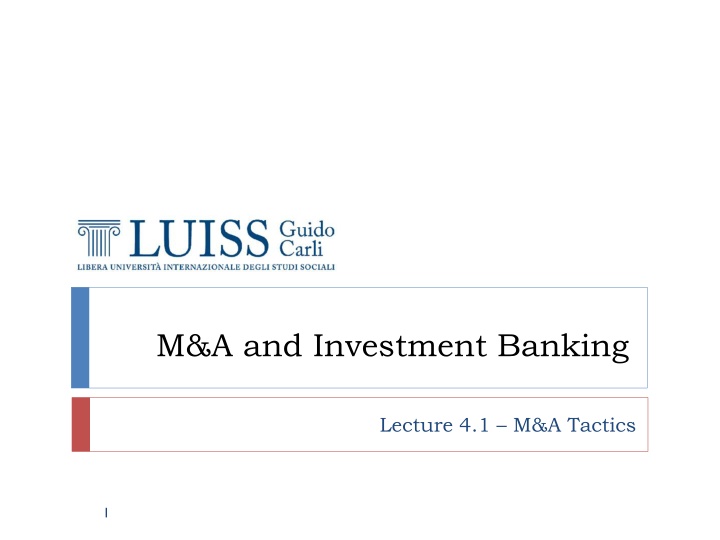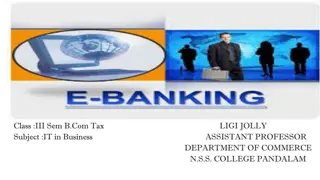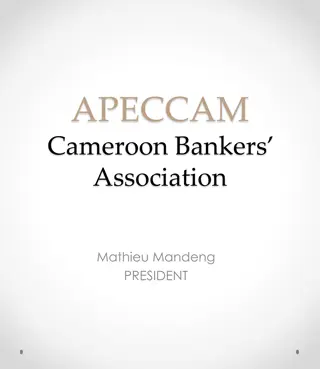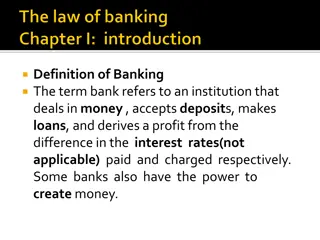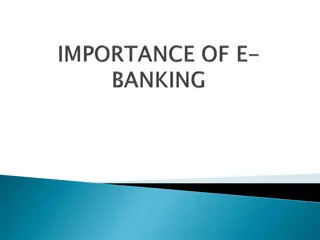Hostile M&A Tactics and Approaches in Investment Banking
Explore the world of hostile M&A tactics in investment banking, focusing on approaches used in public M&A situations. Learn about the pros and cons of hostile takeovers, including advantages such as seizing PR initiative and disadvantages like reputational damage. Dive into key steps and options in approach tactics, from private engagements with target boards to going public with a bear hug strategy.
Download Presentation

Please find below an Image/Link to download the presentation.
The content on the website is provided AS IS for your information and personal use only. It may not be sold, licensed, or shared on other websites without obtaining consent from the author.If you encounter any issues during the download, it is possible that the publisher has removed the file from their server.
You are allowed to download the files provided on this website for personal or commercial use, subject to the condition that they are used lawfully. All files are the property of their respective owners.
The content on the website is provided AS IS for your information and personal use only. It may not be sold, licensed, or shared on other websites without obtaining consent from the author.
E N D
Presentation Transcript
M&A and Investment Banking Lecture 4.1 M&A Tactics 1
M&A Tactics Art or Science? Hostile Shareholder Activism 2
M&A Tactics Hostile M&A 3
Hostile M&A Hostile M&A is really only possible in public M&A situations As a bidder in a private sale process, there are opportunities to exert pressure on a seller, but truly hostile bid tactics are the preserve of public M&A Hostile M&A comes in many forms, but at its core involves making an offer to public shareholders (formally or informally) that bypasses the target s management or board Exerting pressure through publicity has become an increasingly common tactic in recent years 01 14 YTD EMEA Public M&A: % of Hostile Transactions 1,926 102.1 1,482 28.7 1,247 5.1 1,069 1,051 1,062 956 17.2 0.1 913 886 276.5 81.4 0.4 1824.1 1.1 778 670 68.6 651 1453.2 2.0 566 556 10.0 1242.0 9.4 8.8 1050.6 1045.1 912.2 885.4 874.7 792.6 709.6 668.4 640.8 556.5 547.6 2001 2002 2003 2004 2005 2006 2007 2008 2009 2010 2011 2012 2013 2014YTD Friendly Hostile 4 Source: Thomson Reuters as at 20 August 2014.
Hostile Pros and Cons Friendly Hostile Advantages Advantages Can acquire a target against the management s wishes Seizes PR initiative Greater control over timing of announcements and offer timetable Friendly and recommended by the board Board support may reduce likelihood of counter bid Greater level of due diligence possible Ongoing co-operation from management Disadvantages Possible reputational damage to offeror Higher risk / uncertainty target incentivised to seek alternative solutions (i.e.white knights) No due diligence access or co-operation with respect to regulatory issues Greater costs Higher premium likely Unwanted press attention Unlikely to close early in 60 day timetable Institutional shareholders can be averse to hostile bids Cannot implement via a scheme of arrangement Traditionally lower premium Likely to run to shorter bid timetable Board irrevocables Possible to implement via a scheme of arrangement Possible to address any regulatory / anti-trust issues with co-operation of the Offeree Disadvantages Risk of leak Cost of board recommendation and support Management control of enlarged group may be compromised 5
Approach Tactics: Key Steps and Options Typically a potential bidder will seek to engage with the target board in private in order to secure a recommendation before considering other tactical options Accept Key Terms Due Diligence Announce Offer Walk Away 1 Private Approach Made to Target Board Meet to Clarify Terms Board to Consider Terms 2 Go Public Bear Hug Usually initiated by a call to the Chairman (or CEO) Can be helpful to have meeting with the potential bidder (may be through advisers) to get clarity on offer terms Value and assumptions Deal structure Diligence requirements Confidentiality Financing Intentions for the business Financial adviser to assist with evaluation of offer terms and provide advice on recommendation Bidder Options 3 Hostile Bid Improve Terms Followed by an offer letter Reject Seek Improved Terms Reject Just Say No Target options Seek White Knight Other Defence Options 6
Approach Tactics: Spectrum of Potential Approach Strategies 1 Private Approach Seek Board Recommendation Majority of bids initiated via a private approach Decision to go public 2 Public Statement and Engagement with Shareholders Bear Hug Fuller Announcement of Intentions e.g. Price Full Announcement Subject to pre Conditions Short Announcement of Interest / Rejection May be triggered by a leak / / / / / 3 Go Hostile Launch Unrecommended Offer Launch Hostile Offer / / / 7
Strategies to Avoid Being Targeted Peer and Sector Review Declining valuation metrics, missing the numbers or other signs of financial weakness (particularly as compared to peer) should prompt immediate focus on rectifying financial performance Focus on short and long term shareholder value Waiting for the sector or economic conditions to improve is unlikely to be sufficient Review of Investor Base and Trends Monitor investor base Monitor actively trading volumes and ownership trends Keep track of equity, debt and convertible securities holders Maintain a proactive and constant dialogue with all investors/classes of investor Tailor presentation and messages to hedge funds Engage in dialogue with equity advisory services (when appropriate) Keep credit rating agencies informed Actively build-up supportive shareholder base Capital Structure and Distribution Review Optimize capital structure and cost of capital Historically, share repurchases and increased dividend Now, focus on financial stability and size 8
Strategies to Avoid Being Targeted (Contd) Portfolio Optimization Evaluate regularly whether mix of businesses and activities is optimized Focus on core competencies Monetize low growth assets Highlight value of high growth assets Review Takeover Defenses Review the strategic and financial alternatives on a regular basis Review Business Plan, operating performance and competitive positioning Have up-to-date structural defenses available, where allowed Maintain an open shareholder dialogue Ensure Supervisory Board / Non Executive Support Supervisory board/non-executive support is important A supervisory board that is used to be involved in the company s affairs is more likely to support management in a crisis than a pure ceremonial board 9
Defense Tactics Preemptive Reactive Anti-takeover Amendments (Shark repellents) Charter changes that aim at limiting a Bidder s ability to get the control of the Target, e.g.: Staggered boards Fair price provision Super-majority provision Dual class recapitalization Restructuring Divestures and break up transactions: sale of crown jewels Acquisition of undesirable assets Share repurchase or leveraged recapitalization to increase the leverage of the Target to intolerable levels for the Bidder Golden Parachutes Provisions that generously compensate the top managers in case they are fired after a change in control Greenmail The Target repurchases its shares from the Bidder at premium, in exchange for the Bidder s agreement not to make an hostile bid over a given time span Labor Agreements Union representatives might be part of the board of directors. Since hostile takeovers typically result in downsizing the Target, labor representatives are likely to oppose an attack White Knight Friendly Bidder to contrast the hostile bid White Squire Company purchasing a block, without gaining control Poison Pills Issuance of securities to make costly and difficult to gain control of the Target Pac-Man The Target launching a counter bid on the Bidder Poison Puts Covenants that grant bondholders the right to sell Target bonds at par (or even above par) in case of a change in control Litigation 10
Case Studies Olivetti Takeover of Telecom Italia (1999) Defense plan not approved at shareholder meeting. The Italian Government didn t use its golden share with veto power White knight (Deutsche Telekom) not successful Olivetti ultimately purchased 52% of Telecom Italia s voting shares at a cost of 31bn Vodafone Takeover of Mannesmann (2000) It was an hostile takeover but the merger was backed in a private deal. The Mannesmann board agreed to an increased offer of 112bn, then the largest corporate merger ever Never before in Germany had a large company been acquired by a foreign owner Total Takeover of Elf Aquitaine (2000) Elf Aquitaine counterbid (Pac-Man defense strategy) but institutional investors strongly preferred Total s deal 11 Source:Kruse, T., 2005. Ownership, Control and Shareholder Value in Italy: Olivetti's Hostile Takeover of Telecom Italia. ECGI - Finance Working Paper No. 83/2005 http://papers.ssrn.com/sol3/papers.cfm?abstract_id=728284; http://www.nytimes.com/1999/09/21/business/a-french-concoction-totalfina-s- acquisition-of-elf-may-be-only-a-prelude.html?pagewanted=all&src=pm; http://news.bbc.co.uk/2/hi/business/445868.stm http://papers.ssrn.com/sol3/papers.cfm?abstract_id=728284
M&A Tactics Shareholder Activism 12
Hostile - Shareholder Activism Shareholder Activism: a way in which shareholders can assert their power as owners of the company to influence its behavior Source of monitoring of managers and/or blockholders (principal-agent relationship) Shareholder Activist: a shareholder who attempts to use his or her rights as a shareholder of a publicly-traded corporation to bring about social change 13
Who are the Activists? Types of Shareholders Large Shareholders Individual Shareholders Institutional Shareholders: banks, insurance companies, retirement or pension funds, investment advisors The Old: Defensive Activism (ex-post): the investor disagrees with managers decisions and reacts to protect or enhance the value of pre-existing holdings (i.e.: Reluctant Activist) Traditional Institutional Investors as mutual and pension funds (e.g.: CalPERS, CalSTRS) The New: Offensive Activism (ex-ante): specialized activists, lacking a sizeable stake in the target, build up one offensively with the intention of actively prompt changes to maximize their investment return Specialist Activists and Activist Hedge Funds (e.g.: Knight Vinke Asset Management, Hermes Fund Managers TCI, Cevian, Icahn Partners) 14
Can activism deliver over the long-term? Total Return S&P Index vs. Selected 2005 Activism Portfolio Credit Crunch Begins 160.0 140.0 Lehman/AIG 120.0 116.6 102.1 100.0 80.0 60.0 May 05 May 06 May 07 May 08 May 09 May 10 Jan 05 Jan 06 Jan 07 Jan 08 Jan 09 Jan 10 Sep 05 Sep 06 Sep 07 Sep 08 Sep 09 S&P 500 Composite Acitvism Portfolio Does This Graph Imply that Activism Will be Less Successful When There is Less Liquidity? 15 Source: Institutional Shareholder Services (ISS) data as of 22 June 2010; includes 41 activist situations tracked by ISS in 2005
Range of Activist Shareholder Objectives BA-CA (Various) ABN Amro (TCI) TUI (Wyser-Pratte) TUI (Wyser-Pratte) Techem (Various) HVB (Various) Wyevale (Laxey) Curanum (Wyser-Pratte) Freenet (Various) Cumerio / Norddeutsche Affinerie (A-Tec) Dis Deutscher Industrie Service (Various) Cadbury Schweppes (Nelson Peltz) Sainsbury (Tchenguiz) Lagadere (Wyser-Pratte) Wella (Various) Valora Holding (Golden Peaks Capital, Pictet-Fund, 3V Asset Management) Minerva (Kifin) HSBC (Knight-Vinke) Frustrate M&A Capital Measures/ Integration Influence Decision Making Process Increase Capital Distribution Influence Takeover Outcome Change Management Team ` Monetise other Assets Fair Takeover Compensation Break-up Sell Company Philips (Jana Partners, D.E. Shaw Group) Deutsche Borse (TCI, Atticus) Elan (Cabtree) Old Mutual (Cevian) Mitchells & Butlers (Piedmont) ENI (Knight-Vinke) Deutsche Borse (TCI, Atticus) 16
Stages of Shareholder Activism Activist funds typically have team of analysts reviewing undervalued companies Many will take significant time to get to know business and perceived opportunity Identification of Target Activist investor takes initial position in target typically 5% - 15% May choose to build over time or buy in one block Share price may react strongly to presence of investor on the register Initial Acquisition Investor seeks meetings with key management / board figures to discuss perspectives on business Frequently also send formal letter to board setting out perceived short-comings in current strategy and suggested improvements Private Correspondence with Board Starts with mere presence on the register, particularly for the well-known funds Will be ratcheted up depending on progress with the Board Leaks / press briefings or open letter Likely to be coordinated with approaches to other key shareholders PR Campaign Rights to requisition EGM common to most markets Typically seeks to place representation on the Board (or remove existing board) rather than requiring specific action Typically dependent on gaining support of majority of shareholders who vote Requisition EGM Much less common in European situations than in the US Lack of poison pulls, no-jury trials, potential for award of costs Litigation 17
Shareholder Activism in Europe is Here to Stay Background Traditionally, activism has been seen as a US Phenomenon, with European Investors tending not to intervene in the running of their portfolio companies While EU legislation is creating a common base of applicable laws and regulations, historically some jurisdictions have had very different starting places to the US in terms of Board structure Availability of, and appetite for, litigation Shareholder based (including cross-holding structures) Political and market environments Primacy of shareholder value However, the activist model is taking root in Europe and institutions such as ISS are becoming increasingly important in determining the outcome of shareholder campaigns The market in Europe has evolved, with shareholder activism now recognised as a legitimate economic activity which can, in some cases, be beneficial for companies and shareholders as a whole A shareholder prepared to challenged an incumbent board of a European company will find a range of tools at its disposal and increasing support and engagement of vanilla investors Some Recent Examples Shareholder activism has been a common phenomena in the US for some time. US funds are now looking to Europe as demonstrated by Elliott with Actelion (as well as Danisco and National Express). 18
Minority Rights UK Germany France Italy Spain 3% 3% 5% 2% 3% Disclosure Threshold But in practice 212 notices out investor earlier Specific company by- laws, often 1% or even below 10% 5% 10% 10% 5% Power to call EGM Board has to fund circular to all shareholders AoA may provide for a lower threshold 25% for special resolution (changes to articles, schemes, share capital) 25% for special resolution 33% for special resolutions >1/3 of votes in EGM 33% for special resolutions 50% for ordinary 50% ordinary resolutions provided that AoA do not provide for different majority 50% for ordinary 50% for ordinary Blocking Thresholds 50% for ordinary 30% 30% 30% (new regulation being implemented) 30% 30% Bid price equal to or greater than highest price paid in past 6 months Bid price equal to or greater than weighted average price over past 3 months Bid price equal to or greater than highest price paid in the past 12 months Bid price equal to or greater than highest price paid in the past 12 months Marketing Bid Level Bid price equal to or greater than highest price paid in past 12 months 50% Supervisory Board is elected by the general assembly with > 50% Simple majority (i.e. 50%) but by-laws often introduce specific procedures 50% Simple majority (i.e. 50%) but by-laws often introduce specific procedures Election/ De-selection of Board Members of Supervisory Board may be dismissed by general assembly with > 75% 19
M&A and Investment Banking Lesson 4.2 Contract Negotiation 20
Contract Negotiation Sales and Purchase Agreement Due Diligence Process 21
Contract Negotiation Sales and Purchase Agreement 22
Sales and Purchase Agreement Legally binding contract between the acquiring and selling parties. It is subject to conditions such as shareholder approval The contract can take the form of a stock purchase agreement, asset purchase agreement, tender offer document, or merger agreement The SPA is a risk management device focused on the completion of the transaction Therefore it may not include further details such as synergies, plans for integration, governance and organization, etc. 23 Source: Bruner, 2004. Applied Mergers and Acquisitions. Wiley Finance: chapter 29
Key Sections in Purchase and Sale Agreements Section Highlights Details the structure and mechanics of the transaction Specifies purchase consideration amount and form (e.g. cash, stock, or mix) Purchase Price Adjustments clauses Execution Provisions Representation s and Warranties Details exactly what is being bought and sold, and its condition Seller represents that it has clean title to (i.e. ownership of) the property being sold Outlines each parties' ability to act Agreements to take (or not to take) certain actions between signing and closing For example, covenants define who must seek regulatory approval Requires the seller to operate the business as normal and not impair the business by firing employees, for example Covenants Conditions to Closing Conditions that must be met before closing can take place, such as regulatory approval, shareholder approval Termination Provision Conditions upon which the transaction may be terminated, such as a higher bid received by the seller or the buyer's inability to secure financing Specifies the amount that must be paid by the seller (buyer) to the buyer (seller) if the seller (buyer) terminates the transaction Break-Up Fees 24 Source: Bruner, 2004. Applied Mergers and Acquisitions. Wiley Finance: chapter 29
Purchase Price Adjustments Type Comments Most important for financial buyers who are trying to arrange financing and where working capital may impact the credit statistics Detailed adjustments are often made in working capital-intensive and/or seasonal industries, such as retailing Negotiation of working capital adjustment clauses centers on establishing the appropriate target level of working capital Working Capital Adjustments When net debt is to be assumed by the buyer, it is important to define how net debt is calculated and determine how much debt is expected to be on the balance sheet at closing Define whether the price is defined in terms of enterprise value or equity value Define whether cash flows of the business between signing and closing are allocated to the buyer or, more typically, the seller (important in businesses that are cash flow negative) Net Debt Adjustments Occurs where an acquirer insists on an adjustment to reflect business performance between signing and closing - Especially true in situations where there is uncertainty as to the underlying business performance or the financial estimates in use E.g.: If an acquisition and the related financing is made on the basis of an EBITDA multiple, the buyer may want to be able to adjust the purchase price to reflect any deterioration of the business Operating Metric Adjustments 25 Source: Bruner, 2004. Applied Mergers and Acquisitions. Wiley Finance: chapter 29
Covenant Categories Category Comments Regulate the operation of the business for the purpose of ensuring that the buyer gets the business in the form and condition it expects Adjustments for capex and management of cash flows are generally tied to the purchase price adjustments in the execution provisions Operation of Business (handcuffs) In general, the seller agrees to operate the business in the "ordinary course", limiting the target's ability to make acquisitions or dispose of assets between signing and closing In general, the seller agrees to refrain from undertaking certain actions specified in the contract, e.g.: terminating employees The seller and buyer agree to use certain "efforts" to complete the transaction: this can range from "best efforts" to "reasonable efforts" "Efforts" There is often a specific regulatory efforts covenant which commits the buyer and seller to jointly work towards obtaining the necessary regulatory approvals If the buyer needs financing, the agreement may contain a specific covenant for the buyer to take certain efforts to obtain the financing Financing Together with the "efforts" clause, this clause may determine the specific level of the commitment required of the financing (e.g. fully committed, best efforts) 26 Source: Bruner, 2004. Applied Mergers and Acquisitions. Wiley Finance: chapter 29
Contract Negotiation Due Diligence Process 27
Due Diligence Definition & Principles Definition An investigation or audit of a potential investment. Due diligence serves to confirm all material facts in regards to a sale Generally, due diligence refers to the care a reasonable person should take before entering into an agreement or a transaction with another party Principles Avoid a compliance mentality and adopt an investor mentality (look at the risk-return trade-off ) Due diligence is a risk management device Narrow- vs. Broader-scope due diligence: risk bearing is always costly Broader-scope Due Diligence: Yields the basis for thinking like an investor. Focus mainly on wise acquiring rather than on legal issues. (Higher cost of the due diligence, but lower risk surprise now) Narrow Scope Due Diligence: Focus mainly on the legal and accounting issues to get the deal done. Should be bundled with other risk management devices. (Lower cost of the due diligence, but higher risk surprise later) 28 Source: Bruner, 2004. Applied Mergers and Acquisitions. Wiley Finance: chapter 8
What to Look for in a Due Diligence Accounting Issues Legal Issues Tax Issues Risk and Insurance issues Information Technology Environmental issues Market Presence and Sales issues Real and Personal Property issues Operations Intellectual and Intangible Assets Cross-Border issues Finance Organization and Human Resources Culture Ethics 29 Source: Bruner, 2004. Applied Mergers and Acquisitions. Wiley Finance: chapter 8
Due Diligence Process: Timing Due Diligence over the Life Cycle of a Deal First Proposal Letter of Intent Deal Contract Signed Closing Focused on public data. Very small team. Due diligence oriented toward strategic or financial benefits of a combination Focused on public and some target private data. Team grows to include important outside advisers and some integration managers. Aims to advise LOI negotiators, and plan detailed due diligence Focused on target private documents as requested by buyer. Target provides data room. Aim is to support negotiators in their preparation of price, representation and warranties and other final terms. Focused on target documents, field visits, interviews, consultants reports. Very large team. Aim is to test representations and warranties in advance of closing, and prepare for post-merger integration 30 Source: Bruner, 2004. Applied Mergers and Acquisitions. Wiley Finance: chapter 8
Due Diligence Process: Team Hypothetical Due Diligence Review Team Attorney, general corporate review Attorney, tax specialist Attorney, regulation specialist Attorney, risk management specialist Attorney, environment specialist Attorney, intellectual property specialist (e.g.: patents) Attorney, pension and benefits specialist Accountant, general audit Accountant, tax specialist Accountant, internal reporting Consultant, information technology specialist Buyer employee, information technology specialist Actuary Buyer employee(s), human resources, compensation, pension, benefits, and training Consultant, human resources, compensation, pension, benefits, and training Buyer employee, risk management specialist Consultant, environment risk assessment specialist Buyer employee, environment risk assessment specialist Buyer employee(s), marketing and sales Buyer employee(s), operations Buyer employee(s), post-merger integration specialist Buyer employee, cash management Buyer employee, finance and valuation Consultant, solvency analysis and credit analysis Consultant, business forecast and operations Consultant, real and personal property appraisal Consultant, valuation specialist 31 Source: Bruner, 2004. Applied Mergers and Acquisitions. Wiley Finance: chapter 8
Due Diligence Process: Outputs Primary work papers and other resources These are the raw material of the diligence effort (i.e.: list of records checked, work papers and notes from the checking process, transcripts and audiotapes from interviews, videotapes from field visits and inspections, photographs, etc.) Summaries by specialists In each of the areas of focus a specialist should be tasked with preparing a summary of findings Diligence synthesis Technical overview of the entire due diligence effort usually written for the benefit of negotiators, and to combine the specialists findings for possible future reference Integration recommendations Recommendations for integration planners, that begin their work after the signing of the definitive agreement and draw on the findings from the diligence review Executive summaries Summaries suitable to informing and guiding executives along the way 32 Source: Bruner, 2004. Applied Mergers and Acquisitions. Wiley Finance: chapter 8
References Bruner, 2004. Applied Mergers and Acquisitions. Wiley Finance: chapters 8, 29, 30, 32-34 Fleuriet, 2008.Investment banking explained, McGraw-Hill: chapter 14 Iannotta, G., 2010. Investment Banking, Springer-Verlag Berlin Heidelberg: chapter 9 Kruse, T., 2005. Ownership, Control and Shareholder Value in Italy: Olivetti's Hostile Takeover of Telecom Italia. ECGI - Finance Working Paper No. 83/2005 Miller, E.L.J., 2008. Mergers and Acquisitions: A Step-by-Step Legal and Practical Guide. Wiley: chapter 2 33
